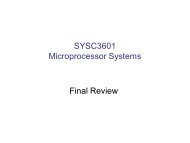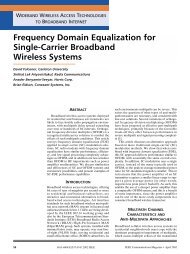Image Reconstruction for 3D Lung Imaging - Department of Systems ...
Image Reconstruction for 3D Lung Imaging - Department of Systems ...
Image Reconstruction for 3D Lung Imaging - Department of Systems ...
Create successful ePaper yourself
Turn your PDF publications into a flip-book with our unique Google optimized e-Paper software.
4.1 Introduction<br />
Electrical impedance tomography (EIT) attempts to calculate a stable and accurate image<br />
<strong>of</strong> the conductivity or conductivity change within a medium from electrical measurements<br />
made on the medium boundary. The image reconstruction problem is essentially underdetermined<br />
and characterized by a system matrix with large condition number. <strong>Image</strong><br />
reconstructions obtained through naïve methods such as least squares are unstable and<br />
dominated by noise. The problem has been overcome through the use <strong>of</strong> various regularization<br />
methods which produce useful solutions by imposing additional conditions (priors), such<br />
as image smoothness, on the problem [113]. The trade-<strong>of</strong>f between solution con<strong>for</strong>mance to<br />
the measured data and con<strong>for</strong>mance to the prior is controlled by a scalar hyperparameter,<br />
<strong>of</strong>ten labelled λ.<br />
A difficulty with experimental and clinical EIT reconstruction algorithms is the tendency<br />
<strong>of</strong> algorithms to rely on subjective methods to select a hyperparameter. The absence <strong>of</strong> objective<br />
hyperparameter selection methods results in several issues which hinder experimental<br />
and clinical use <strong>of</strong> the technique: (1) users <strong>of</strong> EIT <strong>for</strong> clinical applications are uncom<strong>for</strong>table<br />
using ‘fiddle’ adjustments to modify images, (2) comparisons <strong>of</strong> EIT reconstruction algorithms<br />
can be subjective due to the necessity <strong>of</strong> manual tuning <strong>of</strong> hyperparameter values,<br />
(3) experimental work is not repeatable if disparate researchers cannot objectively recreate<br />
the hyperparameter values used in the work <strong>of</strong> others and (4) meta-algorithms, such as<br />
detection <strong>of</strong> electrode errors [7], require a method to fix these values.<br />
In order to address this issue, we investigate some existing hyperparameter selection<br />
methods and propose a new calibration based method called BestRes (Best Resolution).<br />
By ‘calibration’ we mean that a procedure is defined to select a value <strong>for</strong> a given EIT<br />
system and measurement configuration rather than <strong>for</strong> each image or data set. We define<br />
a configuration as the combination <strong>of</strong> current injection pattern, finite element mesh<br />
(FEM), assumed prior conductivity (σ0) and regularization prior. Consequently, the objective<br />
hyperparameter methods discussed in this paper are functions <strong>of</strong> this configuration.<br />
Hyperparameter selection methods are then compared <strong>for</strong> several one-step linearized EIT<br />
reconstruction algorithms.<br />
4.2 Methods<br />
This paper addresses the problem <strong>of</strong> objective hyperparameter as follows: in the methods<br />
section we describe the family <strong>of</strong> EIT reconstruction algorithms used throughout this paper.<br />
In hyperparameter selection methods we describe five hyperparameter selection strategies,<br />
including a new calibration-based method called BestRes. In the results, we describe the<br />
effectiveness <strong>of</strong> each strategy and compare the per<strong>for</strong>mance <strong>of</strong> the objective methods with<br />
heuristic selection. In the discussion we consider some additional observations <strong>of</strong> this work.<br />
We conclude with a recommendation <strong>of</strong> the BestRes hyperparameter selection method.<br />
We consider EIT difference imaging, which is widely understood to improve reconstructed<br />
image stability in the presence <strong>of</strong> problems such as unknown contact impedance,<br />
inaccurate electrode positions, nonlinearity, and the use <strong>of</strong> 2D approximations <strong>for</strong> <strong>3D</strong> electrical<br />
fields [18] [87]. Initially, we address the class <strong>of</strong> normalized one-step linearized reconstruction<br />
algorithms that calculate the proportional change in a finite element conductivity<br />
distribution, x = (σ2 − σ1)/σ1, due to a proportional change in difference signal,<br />
z = (v2 − v1)/v1, over a time interval (t1,t2). By convention we consider the signal at t1<br />
to be the reference frame and the signal at t2 to be the data frame. Since we do not know<br />
σ1, x is interpreted as the proportional change in conductivity with respect to the unknown<br />
47





